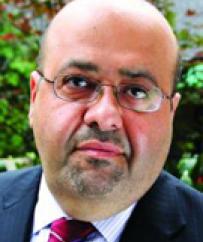Adel Hagekhalil, Assistant Director of the City of Los Angeles Bureau of Sanitation, provides MIR with a another is a series of essays on clean water projects in Los Angeles. While rain in Southern California falls infrequently, it often manages to cause flooding and to wash pollution into the ocean. The Hansen Dam Restoration Project and the Elmer Avenue Green Street Project are examples of the efforts to drain rainwater into the ground where it is cleaned naturally. The City’s partnerships on water and landscape design stand out as some of the most innovative projects taking place in US cities today, making use of the region’s ecological infrastructure.

Adel Hagekhalil
"Clean water projects are no longer “out of site” and underground but rather visible and integral parts of our neighborhoods." -Adel Hagekhalil
Across the City, there is huge excitement about clean water and what it means to our communities. That excitement is a result of a new breed of water quality projects that are being built in the hearts of our neighborhoods. Clean water projects are no longer “out of site” and underground but rather visible and integral parts of our neighborhoods. Angelinos, young and old, now can see, feel, touch, and enjoy these Clean Water projects and improvements.
In the last issue of The Planning Report, I highlighted a landmark project in the heart of South Los Angeles known as the South Los Angeles Wetlands Park. This issue I will be highlighting two recent green projects in the San Fernando Valley.
Every time it rains in Los Angeles, billions of gallons of water flow down of streets, neighborhoods, channels, rivers, and waterways, carrying pollution and waste, flooding intersections, and washing topsoil away. The new paradigm shift is to harness that valuable resource, capture it, treat it, and use it in a green and sustainable way that enhances our communities.
This is done through innovative multibenifit projects. In May 2012, Los Angeles will put into effect a landmark ordinance for Low Impact Developments (LID) that will require all development and redevelopment in the city to capture, treat, infiltrate and/or use the first three quarters of an inch of rain on the property. This LID ordinance was developed in partnership and collaboration with the various community and business groups.
On March 2nd, the community stakeholders along with Councilmember Alarcon and other City officials celebrated the completion of another green project that restored the wetlands in the Hansen Dam Recreation area. The effort implements stormwater quality enhancements to clean up the water, allowing it to be captured and infiltrated back in our underground aquifers while protecting our communities from flooding. The Hansen Dam Wetlands Restoration Project was funded by the voter-approved Proposition O Clean Water bond. The project will manage stormwater runoff from the 133-acre watershed that drains into the Hansen Lake. Through stormwater features like bioswales, infiltration basin runoff from the watershed and from the new parking lot will be captured, treated and infiltrated back into the groundwater all the while creating a beautiful landscape that enhances the area.
Not too far from this project, another landmark project was recently constructed that is a reflection of the future of Los Angeles – Clean, greens and sustainable. The project is Elmer Avenue Green Street at Stagg Street in Sun Valley. Under the leadership of Los Angeles City Councilman Tony Cardenas, the Elmer Avenue Green Street Project was a partnership project with the Council for Watershed Health and Treepeople, along with many other organizations and agencies. The project transformed a street that was prone to flooding into a green oasis with state of the art stormwater management features. Forty acres of runoff used to drain into the area, flooding the community. Now through a system of infiltration pipes under the newly reconstructed street, runoff is captured and channeled unground for infiltration.
Above the ground, the street was reconstructed with bioswales, curb cuts, porous pavements, rain gardens, rain barrels, and many other features to manage the runoff from the 28 homes on the block and infiltrate it back into the precious aquifer. The community worked with the City and its partners to build this project. Every home on the street was retrofitted to manage runoff onsite. I invite you to see the project in person or by watching a YouTube video called “Miracle on Elmer Street” by Treepeople at www.youtube.com/watch?v=bwc K8IWawY0.
To make this even more sustainable, solar powered street lights were installed on the street. With innovation and collaboration, a hazardous flood condition was transformed into an oasis enhancing the community while cleaning runoff and putting it back into our underground aquifer. A second phase of this project is under way called ”Elmer Street Paseo.”
This is an exciting time in Los Angeles as we are witnessing the transformation of our City into the cleanest and greenest City in America - one street and one neighborhood at a time. To sustain this transformation, we need to continue to support integration, innovation, and collaboration and to look for opportunities for implementing these types of green features and elements in every community and project across the City.
My TPR/MIR Restaurant Pick: On my way back from the Hansen Dam Wetlands Restoration project, I stopped at the Nickel Diner at 524 S. Main Street in Downtown Los Angeles. This street has transformed into a great artist and food hotspot. The Nickel Diner is a hidden jewel as are many of our Cleanwater projects. Try their chicken pozole spicy soup and the Nickel burger or the chicken salad sandwich.
- Log in to post comments



